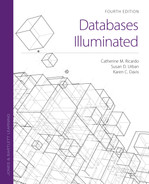12.1 Rationale for Distribution
A distributed database system (DDBS) is one in which multiple database sites are linked by a communications system in such a way that the data at any site is available to users at other sites. Normally, each site or node has a complete information processing system, with its own data administration function, personnel, users, hardware, and software—including a local database, database management system, and communications software. At the very least, a site must have memory and a communications processor. The sites are usually geographically remote and are linked by a telecommunications system, although it is possible to have a distributed system linked by a local area network within a single building or small area. Ideally, users need not be aware of the true location of the data they access, and the system appears to be a local database to them. Depending on the needs of the organization, distributed databases can have many advantages over a single, centralized system that provides remote access to users, including increased local autonomy, improved reliability, better data availability, increased performance, reduced response time, and lower communications cost. DDBSs include traditional SQL-based relational systems, object databases, Extensible Modeling Language (XML)-based and JavaScript Object Notation (JSON)-based databases, unstructured data systems, and NoSQL databases.
